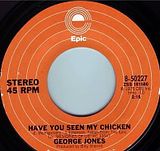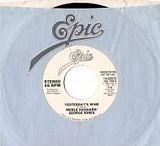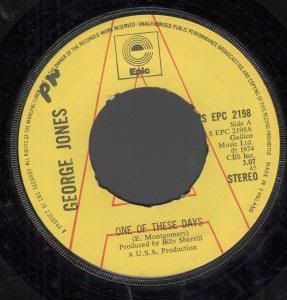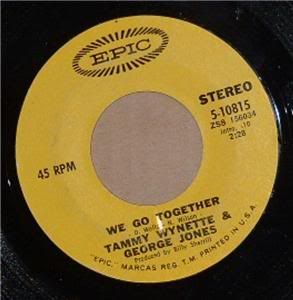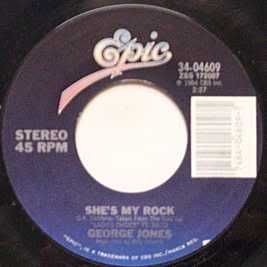 This particular gospel project came along on the Epic label in 1990 but sharp-eared listeners of the project will be quick to realize that the material was recorded years earlier. I have seen cassette copies on-line indicate 1980 while I have a cassette copy in my collection with the year 1979 indicated...I do know that one of the songs on this album was a b-side of a 1979 George Jones single...and so it's pretty much for certain that the material was recorded during 1979/1980. It was also documented that George would include gospel songs in his concerts around this time period...and there's been commentary made on-line about how these songs were originally recorded for a gospel album that was never released...which explains why a 1990 project would consist of nothing but earlier material.
This particular gospel project came along on the Epic label in 1990 but sharp-eared listeners of the project will be quick to realize that the material was recorded years earlier. I have seen cassette copies on-line indicate 1980 while I have a cassette copy in my collection with the year 1979 indicated...I do know that one of the songs on this album was a b-side of a 1979 George Jones single...and so it's pretty much for certain that the material was recorded during 1979/1980. It was also documented that George would include gospel songs in his concerts around this time period...and there's been commentary made on-line about how these songs were originally recorded for a gospel album that was never released...which explains why a 1990 project would consist of nothing but earlier material.The album consists of 10 songs...with The Jordanaires and Millie Kirkham doing the background harmonies. George is credited as co-writer on several of the selections. I like all of the songs and my favorites are the up-tempo numbers but I also like the way he delivers the narratives in the slower songs. "A Picture From Life's Other Side" is just as great as you'd expect it to be; by Hank Williams it's a masterpiece in the gallery of gospel music he's noted for and George, given his appreciation of Hank Williams and for having his own gripping narrative style, it's compelling. It's the second song on the album. The family feud reading of "Mama's Family Bible" kicks off the album. The song is about a house being auctioned off after the death of a mother...with family taking a lot of items one by one but nobody bothered to take the bible that was sitting on a shelf...and the song goes on to tell us that once the family got what they wanted, they ended up selling the items, while he kept the bible and never dreamed of selling it.
The tempo picks up quite a bit on song three, the sing-a-long "Me and Jesus" from the pen of Tom T Hall. The song had been a popular hit for Tom T Hall in the early 1970's and George took his shot at recording the song in the late 1970's...even appearing on an episode of Pop! Goes the Country singing the song with host, Tom T Hall. It's a song about a man who's best buddy is Jesus and they really don't need any preaching or any scolding from those who are self-appointed messengers. It also paints a more liberal viewpoint of things with the lyrics in the song of how Jesus likes all kinds, whether they're up-right and moral or not. Naturally, this kind of song isn't a favorite among the more devout.
Song four is "We Oughta Be Ashamed", which appeared in 1979 as the b-side of "Someday My Day Will Come", in which that song carried touches of gospel over-tones as well.
"The Devil Is Gathering Firewood" closes out side one of the album...an up-tempo song about the battle between the Devil and Jesus winning souls and how sinner's better learn how to get on their knee's and pray before it's too late.
"Would They Love Him" is one of the more pointed songs on the album. It tackles religious hypocrisy and it studies the people who say they are Christians and say they believe in God but would they still love him if he came back and insisted that they give up the things that they covet. "Jesus Saves Today" closes out the album...it's one of the more traditional-sounding gospel songs...most of the other gospel songs were arranged strictly country. In between those two songs we have three up-tempo sing-a-long's. "Swoop Down, Sweet Jesus" is a feelgood song about a man who basically lives inside honky-tonk's until he finds Jesus and the title track, "Hallelujah Weekend", is about a family who has a habit of forgetting Sunday's and we're told of a plan in which the gospel spirit can be celebrated all week long by starting your Monday's with Jesus. "The Battle For Daddy's Soul" is one of my favorites as well...it's the story of a woman who wants her husband to give up drinking and find religion. It's sub-titled "The Bible Against the Bottle".
This album, as of this writing, has never been issued as an MP3 and so you're most likely to find it in cassette or CD form at on-line auction sites.
